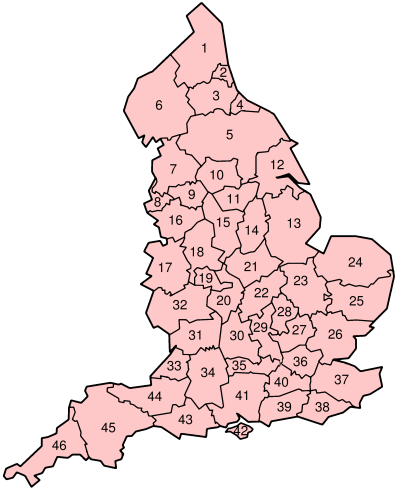User:Bstle/hide
歷史
[编辑]目前的都會與非都會郡劃分制度,是啟用於1974年4月1日,同時該制度也取代了原先的行政郡(administrative counties of England)與郡自治市(county borough)系統。至於同一層級的大倫敦,則是於1965年依據另外的立法而創建。
而到了1990年代,又成立了新型態的非都會郡,也就是單一管理區。此種區劃是將郡與區(district)的功能與權力合併而成。而原先的非都會郡為了與後來的單一管理區有所區分,也因此一般改稱為鄉郊郡。
1972年地方政府法案
[编辑]By the late 1960s, it had become obvious that the structure of local government in England and Wales needed reforming. Harold Wilson's Labour government set up the Redcliffe-Maud Commission to produce proposals for wholesale reform.
The report proposed that for most of England the two-tier structure be abolished, and replaced with a system of 58 unitary authories, which would generally ignore the previous administrative boundaries in favour of changes that made geographic sense - a total redrawing of the map. In the metropolitan areas of Merseyside, South East Lancashire and North East Cheshire, and the Birmingham area, there would be 3 metropolitan areas, with 20 district authorities.
These proposals were opposed by the Conservative Party opposition led by Edward Heath. They won the 1970 general election, and set to work defining their own scheme. This scrapped the concept of unitary authorities (even for existing county boroughs) – the entire area of England and Wales was to be divided into uniform counties and districts. In England the new divisions were to be largely modelled on the traditional counties, but in some areas (quite apart from the metropolitan areas) quite radical reforms were put forward.
Despite reassurances from the government that nobody's loyalties were expected to change as a result of the local government reform, many changes did incur significant local opposition. Most of the radical changes were withdrawn. One aspect the government stood firm on was the mergers of small counties. Campaigns for the continuation of Rutland and Herefordshire were unsuccessful, although due to its special geographic circumstances, the Isle of Wight was permitted to retain a separate county council, as opposed to being reunified with its historic county of Hampshire.
The Local Government Act was passed in 1972, and defined the English counties and metropolitan districts, but not the non-metropolitan districts. These were set by a Boundary Commission that had already begun work.[1]
The metropolitan counties were composed as follows:
- Merseyside - based around Liverpool, south-west Lancashire, along with the Wirral in north-west Cheshire, on the other side of the River Mersey,
- Greater Manchester - the Manchester urban area along with many surrounding towns
- South Yorkshire - based upon the Sheffield-Rotherham area in the West Riding of Yorkshire
- Tyne and Wear - the Tyneside conurbation based on Newcastle-upon-Tyne in Northumberland, along with Sunderland in County Durham
- West Midlands - Birmingham conurbation, including the Black Country and Coventry
- West Yorkshire - Leeds-Bradford area in the West Riding
Other significant changes were:
- Avon formed from northern Somerset, southern Gloucestershire, and Bristol and Bath
- Cleveland formed from southern Durham and northern part of the North Riding, focusing on the Teesside conurbation along with Guisborough and Hartlepool
- Cumbria was formed from Westmorland, Cumberland and part of Lancashire and Yorkshire
- Herefordshire and Worcestershire were merged into Hereford and Worcester
- Humberside formed from eastern Yorkshire and northern Lincolnshire
- Huntingdon and Peterborough was annexed by Cambridgeshire
- Rutland was merged into Leicestershire as a district
- Vale of White Horse, including Berkshire's former county town Abingdon, was ceded to Oxfordshire, as was the area around Wallingford and Didcot now comprising the western half of the South Oxfordshire District
- Bournemouth was moved from Hampshire to Dorset, to join its sister town of Poole
Map 1974-1995
[编辑]Abolition of metropolitan county councils
[编辑]In 1986 the county councils of the metropolitan counties and the Greater London Council were abolished by Margaret Thatcher's government following disputes with central government, but the counties themselves remained legally in existence.
1992年地方政府法案
[编辑]The 1990s led to the restoration of county boroughs under a new name, unitary authorities, which radically changed the administrative map of England. The changes were carried out in several waves.
On April 1, 1995, the Isle of Wight became a single unitary authority. It had previously had a two-tier structure with an Isle of Wight County Council, Medina Borough Council and South Wight Borough Council. Also on this day, two small areas were ceded from Surrey and Buckinghamshire to Berkshire, giving it a border with Greater London.
On April 1, 1996, the unpopular counties of Avon, Humberside and Cleveland were abolished and their former area divided into unitary districts. Also at this time, the York was expanded and separated from North Yorkshire.
On April 1, 1997, the districts of Bournemouth, Darlington, Derby, Leicester, Luton, Milton Keynes, Poole, Portsmouth, Rutland and Southampton became unitary authorities. Also, the districts of Brighton and Hove were merged to form the new unitary authority of Brighton & Hove.
On April 1, 1998, Blackpool, Blackburn with Darwen, Halton, Medway, Nottingham, Peterborough, Plymouth, Swindon, Stoke-on-Trent, Southend-on-Sea, Telford and Wrekin, Torbay, Thurrock and Warrington became unitary authorities. Also, Hereford and Worcester was abolished and replaced by the unitary authority of Herefordshire and the shire county of Worcestershire. Berkshire was split into six unitary authorities, but not formally abolished.
- ^ Arnold-Baker, C., Local Government Act 1972, (1973)




